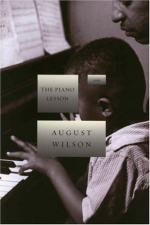|
This section contains 328 words (approx. 1 page at 400 words per page) |

|
The Piano Lesson Summary & Study Guide Description
The Piano Lesson Summary & Study Guide includes comprehensive information and analysis to help you understand the book. This study guide contains the following sections:
This detailed literature summary also contains Bibliography and a Free Quiz on The Piano Lesson by August Wilson.
The Piano Lesson is the fourth of August Wilson's cycle of plays about the African American experience in the twentieth century. It opened at the Yale Repertory Theater in 1987, and, later, on Broadway, to great success.
The play was inspired by Romare Bearden's painting Piano Lesson. It is set in Pittsburgh in 1936 and focuses upon the relationship between the Charles siblings, Berniece and Boy Willie, who clash over whether or not their family's piano should be sold. In the mid-nineteenth century, when the Charles family were slaves, two members of the family were sold by their owners, the Sutters, for a piano. Subsequently, a master-carpenter in the Charles family was ordered by the Sutters to carve the faces of the sold slaves into the piano. He did that and more: he carved the family's entire history into the piano. The instrument was later stolen by Berniece and Boy Willie's father, who was then killed by the Sutters in retribution.
The play explores African Americans' relationship to family history, particularly to the history of their slave ancestors. While Wilson's cycle of plays is set during the twentieth century, all of his plays explore the legacy of slavery and the roots of American racismthis play is as concerned with the Ante-bellum period as it is with America during the Great Depression.
Wilson presents the Charles' different attitudes towards their family history in a naturalistic style: the dialogue accurately reflects everyday dialect, and the action is interwoven with scenes of people preparing meals, hot-combing hair, and bathing. The play's central metaphor, the piano, dominates this structure, while Wilson's inclusion of ghosts and spirits demonstrates his diverse cultural and literary influences. Although a few critics were critical of his mixing of styles and traditions, the majority applauded his imaginative fusion of African, American, and African-American traditions.
The Piano Lesson won Wilson his second Pulitzer Prize and confirmed his status as one of America's most important and innovative living playwrights.
Read more from the Study Guide
|
This section contains 328 words (approx. 1 page at 400 words per page) |

|



